Wondering which Facebook ad placements you should use and why? If you’re familiar with Facebook’s structure for scale, you know that one of their Power 5 recommendations for achieving better results is to use advantage+ (automatic) placements.
But why is that? Well, if you’re curious to find out, stick with us until the end of this blog post. We are going to explain the main differences between manual and advantage+ placements, while also showing you the results of an A/B test we ran.
This way, you’ll better understand the benefits of each placement option, and also discover why we (and Facebook) recommend using advantage+ placements.
What are Facebook ad placements?
The Facebook ads platform has two different placement options you can choose from – Automatic (now called Advantage+ placements) and Manual placements. Every placement essentially indicates the place where your ads can show up.
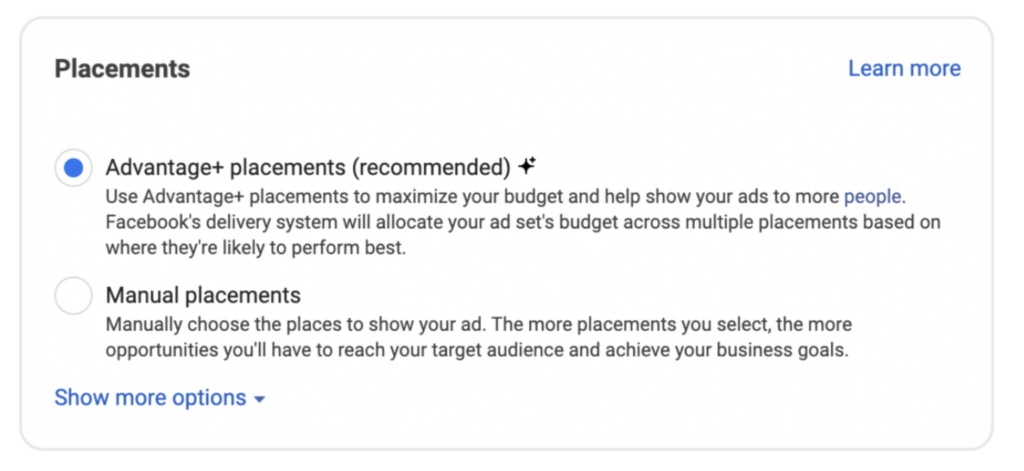
When creating a new campaign in the Ads Manager, you’ll choose your placements settings in the ad set level. You’ll notice that the default option is Advantage+ Placements, which Facebook recommends to use.
We don’t always agree with Facebook’s recommendations but we definitely do on this one, and hopefully, by the end of this blog post, you will, too.
If you’re using Manual placement, the first thing you’ll have to select is the device type – mobile, desktop, or both. If you choose one versus the other you’ll notice that a lot of placements are no longer available.
So for example, if you choose desktop, Audience Network, Messenger and Instagram is no longer an option for you. So make sure to always go for the recommended option, which in this case is – All devices.
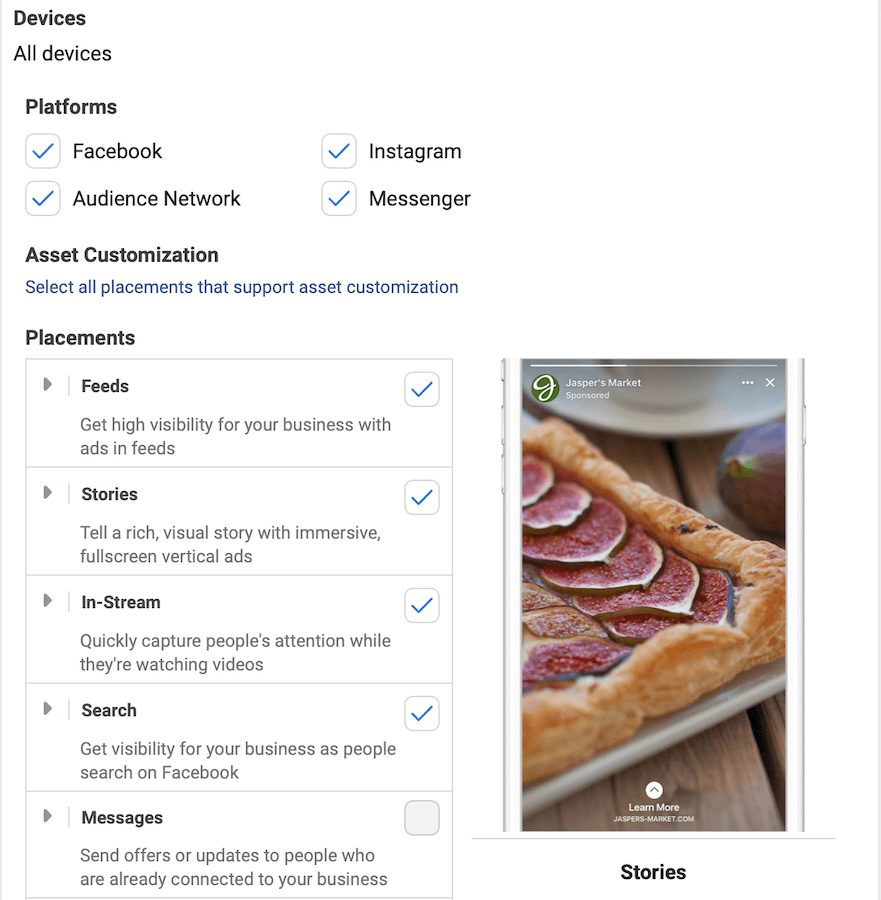
The platforms your ads can appear on are the following ones:
- Audience Network
- Messenger

Before you start selecting placements, you can hover over each one to see how ads would look on different platforms and their placements.
You’ll notice that the ads are for the brand Jasper’s market, which Facebook uses as an example. You could also skip this step and go straight to the ad level to see this for your own ads. Our suggestion is to always build your ad first, and then check what the previews look like.
Manual placements
When using manual placements, you’re the one selecting where you want your ads to appear. A lot of time we see advertisers make a common mistake – they limit their ads to a couple of different placements. By doing this, you’re putting a lot of restrictions on the algorithm, making it hard for it to make the most out of your budget.
Another reason why we don’t like to use manual placements is because you never know on which platform your audience is more active. If the majority of your potential customers use Instagram more than Facebook, using only Facebook placements could mean that you’ll lose those customers.
Additionally, you might limit yourself to the most expensive placements, which can quickly eat up your entire budget.
Automatic placements became Advantage+ placements
Before we dive into why using automatic placement is a better choice, let’s briefly discuss what advantage+ placement is all about. Essentially, automatic placement is just another way of saying advantage+.
To keep things consistent, we’ll use “advantage+” throughout the rest of this blog post when referring to automatic placement.
Why we recommend Advantage+ placements
Advantage+ placements enable you to get the best results available from across all default placements. Essentially, this means that Facebook’s delivery system will allocate your ad set’s budget across multiple placements based on where they’re likely to perform best.
So if a certain placement is not performing well, the algorithm is going to focus on the opportunities across other available placements.
Facebook Placements Algorithm
Now let’s look at an example to better understand how Facebook’s algorithm works with placements.
Say you’re in a situation where the average CAC (customer acquisition cost) on Facebook Feeds is significantly lower than on Instagram Stories. In this case, you might think that it would be good to pause your ads in Instagram Stories and place more of them in Facebook Feeds due to the lower CAC.
The thing you have to remember, though, is that Facebook’s algorithm is designed to get you the most conversions at the lowest average cost overall – not the lowest average cost for each placement.
This means that Facebook takes into consideration all available opportunities across all placements and chooses the least-expensive ones without regard for what the average CAC will be for each placement.
So, let’s say you have 11 opportunities to show your ad on these three platforms, with a budget of $36.
- 3 opportunities on Facebook
- 3 opportunities on Instagram
- 5 opportunities on Audience Network
Now let’s break down the cost of each opportunity (y-axis):
- Facebook – $4
- Instagram – $6
- 3 Audience Network opportunities – $2
- 2 Audience network opportunities – $8
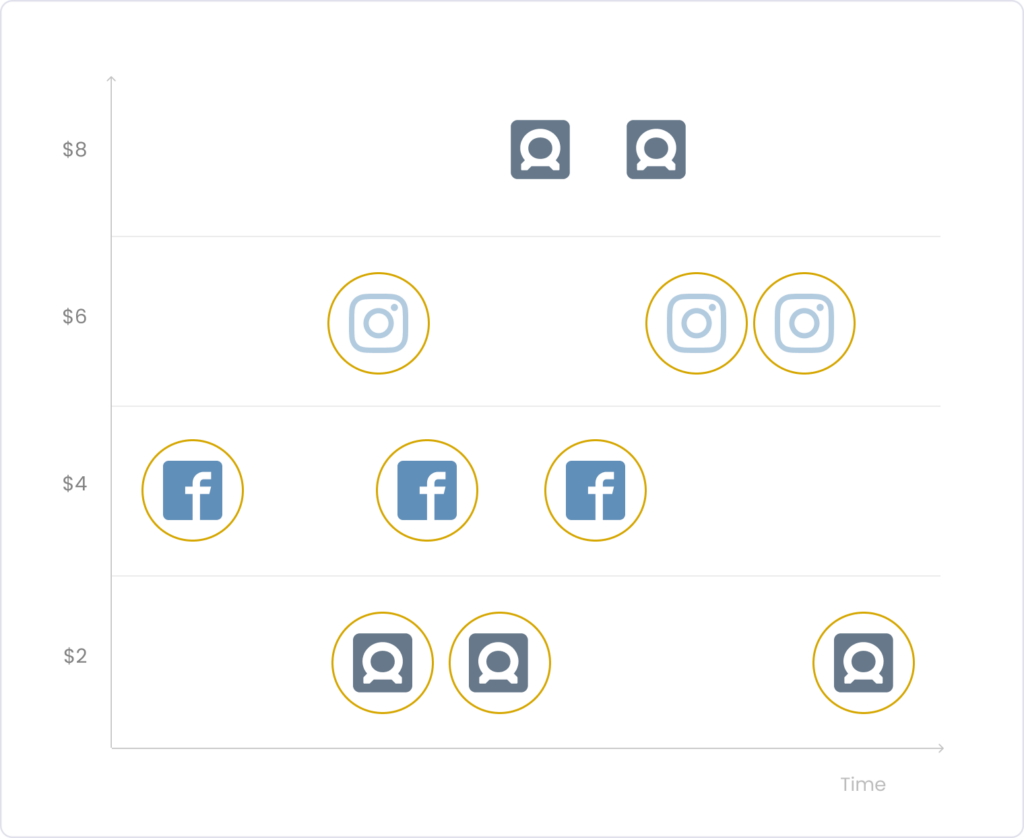
Note: A circle around these icons means the ad was shown in that placement and generated a conversion.
What would happen with Advantage+ placements?
If you’d chosen advantage+ placements, you’d later see in Ads Manager that Facebook placements have an average CAC of $4, Instagram placements have an average CAC of $6 and Audience Network placements have an average CAC of $2.
So essentially, you’d get 9 conversions for $36 at an average CAC of $4 each.
When looking at the performance, some of you would probably turn off the Instagram placement since it was the most expensive one ($6).
You would think you have an opportunity on other placements such as Facebook or Audience Network, but here’s what would really happen:

So in this situation, if you’d choose to turn off the Instagram placements, Facebook placements would have an average CAC of $4. There’d be no Instagram placements and Audience Network placements would have an average CAC of $4.40. So in total, you’d only get 8 conversions for $34 at $4.25 each overall.
This would result in a less efficient spend of your budget than in the first example, where you used all possible placements, and got 9 conversions with an average CAC of $4 each.
Advantage+ or Manual placements: A/B Test
Even though we were pretty confident that using advantage+ placements would result in better performance, we still decided to test it out to confirm our hypothesis. The goal of the test was to see if using automatic placements would result in lower CAC (customer acquisition cost) and CPC (cost per click).
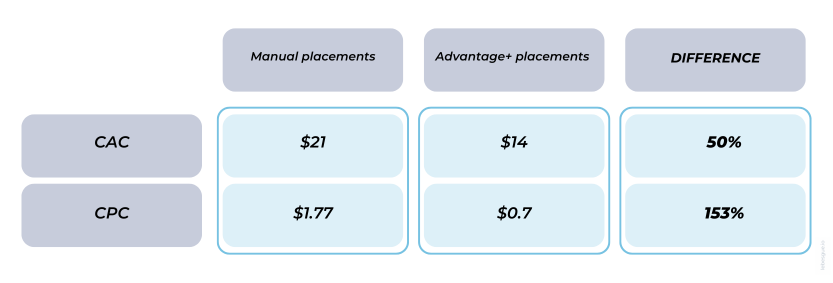
With the test completed, we’ve seen that using advantage+ placements was the clear winner. The CAC decreased by 50%, while CPC decreased by 150%.
In another similar test, we’ve seen that Instagram performs better than Facebook, but only when combined with automatic placements. This really proves that the broadness of the placements allows the algorithm to place ads where the estimated conversion rate will be highest and the CAC lowest.
When deciding between Advantage+ and manual ad placement, we recommend opting for Advantage+. Meta’s algorithms are highly effective at optimizing placements and identifying the audiences most likely to convert.
With Advantage+ placements, you can achieve lower customer acquisition costs (CAC) and cost per thousand impressions (CPM) compared to manual placements.
Analyzing the performance of placements
If you’re curious to see how individual placements performed, you can easily check it in your Ads Manager. In the right upper corner, click Breakdown – by delivery → placements.
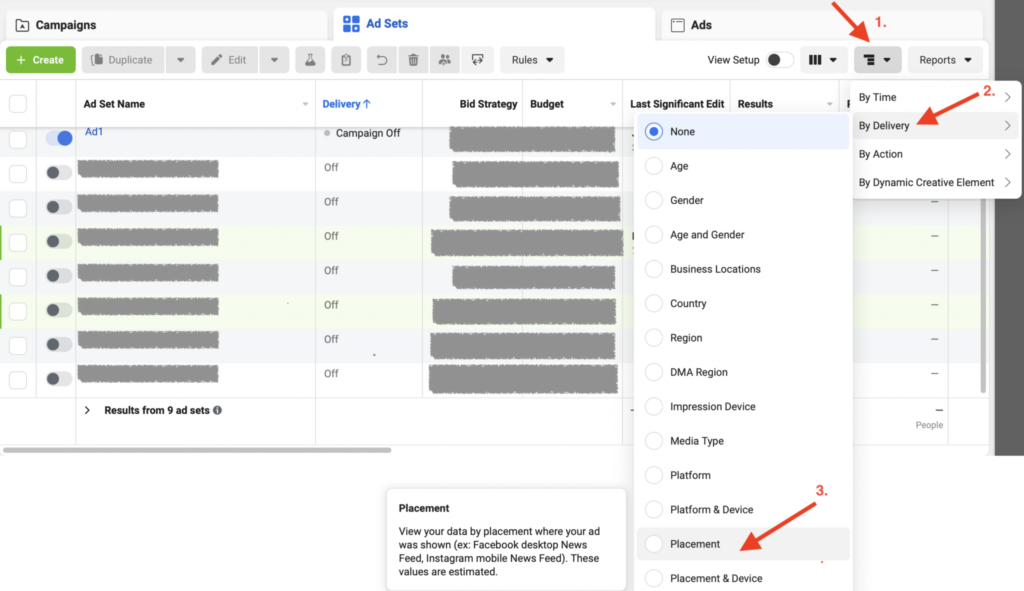
From that point, you’ll see all of your data for each placement that was running in your ad set.
Summing Up
In summary, choosing between manual and automatic ad placements depends on your needs and resources.
However, for many advertisers, using automatic placements like Meta’s Advantage+ is a smart choice. These tools use advanced algorithms to place ads in the best spots and target the right people, often leading to lower customer acquisition costs (CAC) and cost per thousand impressions (CPM).
By using automatic placements, you can save time, reach more people, and run more effective ad campaigns.



